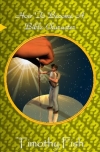
And Thy House
Extra Feature: High Res Image

History of
Cane Creek
Association
by D. F. Magruder
Some Points of View
Written By: Timothy Fish Published: 3/25/2008
 Imagine a scene like the one shown here. A woman is in
bed and there is a bad guy watching her through the window. If we want to
describe this scene in a story, there are many viewpoints that we can use. That
is not to mention the issue of point of view. To simplify things, letís use the
third person point of view.
Imagine a scene like the one shown here. A woman is in
bed and there is a bad guy watching her through the window. If we want to
describe this scene in a story, there are many viewpoints that we can use. That
is not to mention the issue of point of view. To simplify things, letís use the
third person point of view.
Limited Third
Currently, it is in vogue to use what is called a close third person point of view or a limited third person point of view. The idea is that we tell the story from the viewpoint of one of the characters in the scene, but we tell it as if a third person is telling the story. Conceptually, the narrator is in the head of one of the characters. In this scene, this is only possible with either Character A or Character B, since the narrator is invisible and cannot interact with the scene. Letís look at some examples.
Character A View of Scene
A cold breeze kissed her face. She pulled the blankets closer, trying to get warm. She looked at the clock, only to see that it was only a little after midnight. She needed to the sleep, but it was too cold. It shouldnít be this cold. She looked across the room and saw the curtains blowing in the breeze. Through the window, a shadowy figure slipped out into the moonlight and disappeared.
Character B View of Scene
As he raised the window gently, so as not to make a sound, he could see the soft features of the woman inside. She stirred in her sleep. Did he dare go in? He decided to chance it and slipped through the open window. The moonlight gave him enough light to see. He went to the dresser and picked through the jewelry. She had some very expensive looking jewelry, but none of that mattered. He wanted only the little heart shaped locket. It took a few moments to find it in the dim light. When he found it, he slipped it into his pocket, and then hurried to the window. He saw the woman pull the blankets closer, then look in his direction. He didnít want to give her time to recognize him, so out into the moonlight he went. He ran to his car parked on the street and drove away.
Other Viewpoints
If we donít limit ourselves to one of the characters in the scene, we have more options. In the picture, I have shown two of these options in the form of narrators. One is in the room. The other is outside. A narrator can move at will through a scene, but letís consider the scene as if these two narrators are watching from where they are shown on the drawing.
Narrator One View of Scene
Just after midnight, a shadow appeared in the moonlight that shone through the window. The woman on the bed lay still, while a man pried open the window. He looked at the womanís sleeping form and waited while she stirred in her sleep, then he climbed through the window. As if he knew what he sought, he went directly to the dresser and began looking through her jewelry. The diamonds on an expensive bracelet sparkled in the moonlight, but he placed it aside. He kept looking until he found a simple heart shaped locket. He held it up to look at it for a moment, then slipped it into his pocket. He turned quickly and rushed toward the window. He glanced over at the woman, who was now awake. He slid through the window and run across the yard, out of view.
Narrator Two View of Scene
In the moonlight, a man slipped around the corner of the house, went to the window and pried it open. He paused for a moment at the sound of movement on the bed, then climbed through the window. He went to the dresser and rummaged through some of the things on top, until he found a simple heart shaped locket. He slipped it into his pocket and hurried back to the window. More sounds came from the bed. The man climbed back through the window. As he ran across the yard and around the corner, the locket fell out of his pocket and landed on the ground.
Which Is Better?
We see the same story from four different viewpoints, but which is better? That depends on our goal. The Character A viewpoint is probably the most startling. None of us wants to wake in the middle of the night and see someone in our bedroom. The Character B viewpoint reveals more about what the bad guy is doing and why, but the fear is that he will get caught, rather than the danger of having someone in the room. Narrator One is in a better position to reveal the situation from the standpoint of the woman being in danger than what she is. Narrator Two can tell us more about what happened outside.
The theory behind following a point of view character and slipping inside the head of the character, as we did with Character A and Character B, is that the reader is supposed to be able to slip inside the scene, as if he is experiencing the events rather than watching it unfold for someone else. The problem is that the reader is unable to see details that may be important to understanding the story. Distance, better vision or even omniscience is not always a bad thing for a narrator. The key for an author is to know when to use different viewpoints. It is never as simple as saying, pick a character and stick with her, even though some popular authors have used that technique with some success.
www.timothyfish.com



